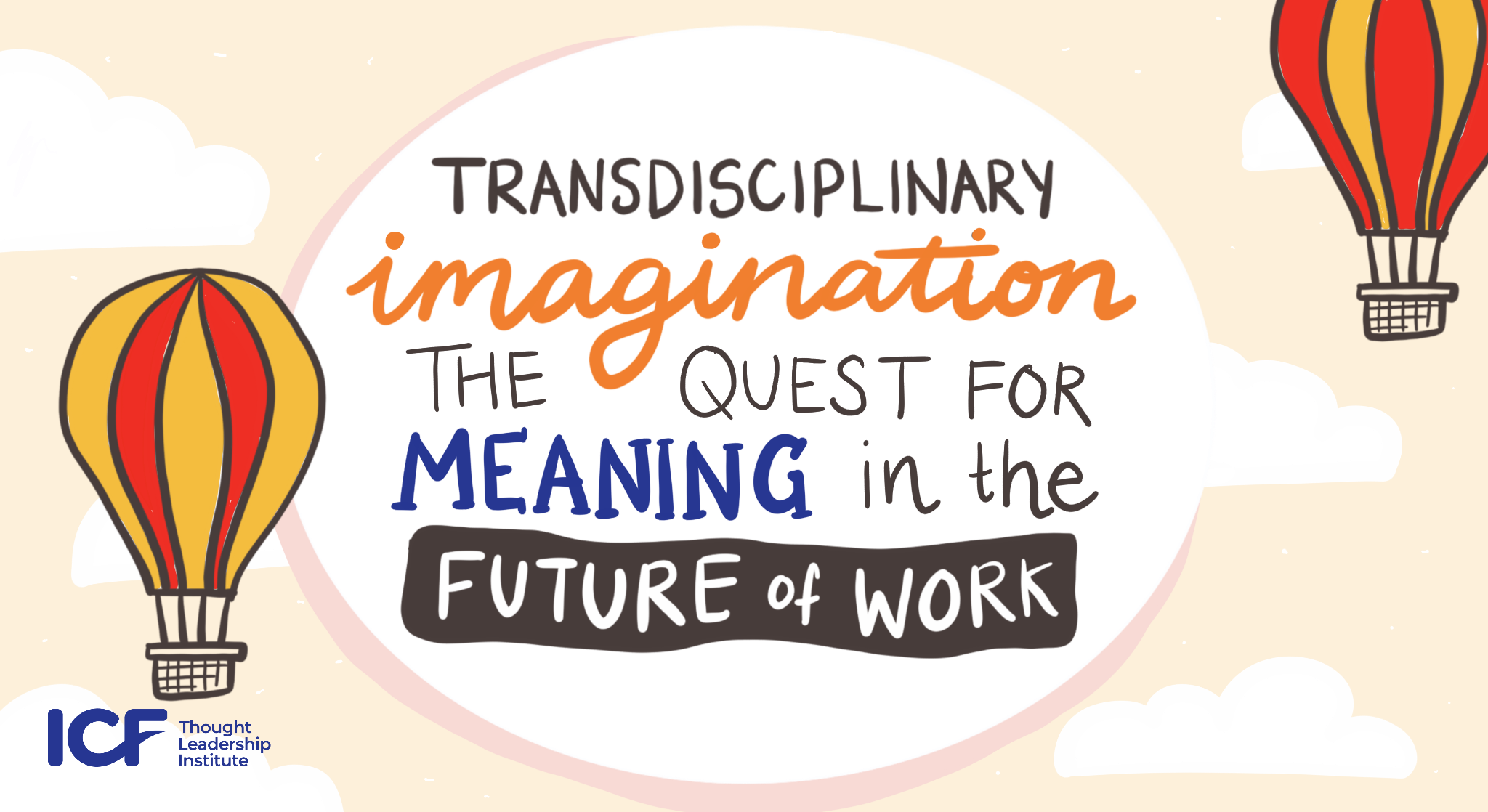Human-centered transformation starts with disrupting workplace norms
Organizations that promote a human-centered culture will continue to attract and retain valuable talent. Coaches can help guide clients through this workplace transformation.
Employee engagement and well-being are struggling on a global level, with implications for organizational performance and longevity
In the aftermath of the Covid-19 outbreak, businesses are struggling to attract and maintain adequate staffing. The global organizational consulting firm, Korn Ferry, estimates that by 2030, 85 million jobs could go unfilled worldwide, leading to significant economic disruptions. While Korn Ferry cites aging populations as a major driver for this gap, research from Deloitte indicates that Millennial and Gen Z workers also have high turnover. In Deloitte’s global survey, respondents reported voluntarily leaving their jobs due to low wages, overwork, and limited growth opportunities. However, the survey also revealed that young workers are likely to stay in a position when offered flexibility, opportunities for development, and alignment with personal values.
For existing staff, engagement goes hand in hand with productivity, whereas a lack of engagement among employees can increase the intention to quit. The 2022 Gallup State of the Global Workplace Report indicates that global engagement is low, with only 21% of employees feeling engaged. Looking at global trends in attrition, a McKinsey survey found that 40% of respondents considered leaving their job, with 66% of respondents from India reporting they were likely to leave their position in the next 3–6 months. McKinsey’s report echoes other workforce surveys noting that key employee engagement and retention drivers are workplace flexibility, meaningful work, support for health and well-being, and a welcoming and inclusive community. Employees were likely to leave when they were overworked, lacked supportive leadership, had limited opportunities for advancement, and reported low wages.
In the future of work, organizations will need to adopt strategies to recruit, retain, and develop talent. In addition to fair compensation and opportunities for advancement, Gartner reveals that employees want a human-centered workplace culture that supports holistic well-being and contributes to a sense of purpose. Human-centered culture upends mechanistic workplace norms by inviting workers to bring their whole selves to work. In contrast to command-and-control, human-centered leaders empower worker autonomy, shared decision-making, collaboration, and accountability.
Coaches can help organizations implement a human-centered culture by guiding leaders to challenge assumptions about traditional leadership and imagine new possibilities for their teams. Managers may benefit from utilizing coaching skills that foster team collaboration and empower employees to take ownership of their work. Coaching can also be a resource to organizations as they work to identify skills gaps and build capacity among existing staff to meet changing needs.
Explore how organizations can use human-centered approaches to reimagine the workplace and what this means for coaches:
- Organizations enhance horizontal decision-making and autonomy
- Marketing and communications engage employees as a key stakeholder
- Flexible work agreements prioritize work-life balance and support diverse teams
- Human Resources support organizations to adapt
Click here for More Resources for Coaches
1. Organizations enhance employee autonomy and horizontal decision-making
With an abundance of available jobs, employees are less willing to work for companies that promote overwork, micromanaging, and command-and-control leadership. Instead, employees are asking for greater choice. Human-centered organizations can support employee autonomy by encouraging horizontal-decision making and choice around when and how tasks are completed.
Horizontal decision-making opens conversations between managers and their teams by inviting employees to express needs, ask questions, and create a shared understanding of project expectations. Increased employee autonomy opens negotiations for task-based vs. fixed work schedules, remote vs. hybrid or in-person work, and shared decision-making opportunities. Some of these negotiations put an extra burden on managers and organizations to balance individual and team needs. For example, managers may need to adapt approaches for employees who need different levels of structure or set aside designated collaboration time for remote employees working on different schedules. However, engaging employees in horizontal decision-making can help employees feel respected even if their manager cannot accommodate every request.
Research on employee empowerment indicates that increased autonomy helps employees work in a way that maximizes their energy and passion to complete tasks more efficiently. Employee autonomy can support greater ownership over projects, empowering employees to creatively solve problems. A study examining business innovation found that when employees experienced greater job satisfaction when they were empowered to drive innovation from the bottom up.
What this means for coaches:
- As organizations enhance employee autonomy and shared decision-making, coaches can help leaders find new ways to measure task completion and maintain accountability
- To facilitate shared decision-making conversations, managers will need skills to invite collaborative discussion, balance dissenting opinions, and bring teams together to problem-solve. Coaches can help managers apply coaching skills to empower employees in horizontal decision-making
2. Marketing and communications engage employees as a key stakeholder
In the human-centered workplace, employees want to feel valued and know that their work matters. Organizations can engage employees as stakeholders by creating tailored internal communication strategies that reflect employee values and interests. Gartner illustrates how organizations will need to offer and communicate a human-centric employee value proposition to meet changing employee needs. Based on a survey of 5,000 global professionals, Gartner found that employees wanted their companies to offer flexibility, opportunities for growth, well-being, shared purpose, and connection. Internal communications can reflect these interests by acknowledging employee achievements and connecting daily work to organizational impact.
These same insights can be used to engage new talent. Job listings for new employees should reflect a human-centered employee value proposition as part of an employer brand, including an emphasis on purpose. Beyond making a living, employees are looking for a greater sense of meaning and an opportunity to impact their communities and the world around them. A joint study by BetterUp and Harvard Business Review found that 9 out of 10 employees would consider taking a pay cut if offered purpose. This data reveals the tangible value of purpose in attracting and retaining talent.
What this means for coaches:
- Organizations will need to communicate organizational outcomes in a way that connects employee efforts to internal and external impact. Coaches can help leaders examine how purpose shapes corporate activities
- Coaches can help leaders to learn what purpose means to their workers and to align business values and operations to support a shared sense of purpose
- Human-centered culture engages employees as valuable stakeholders. Coaches can help organizations consider how internal communications and recruiting materials express employee value
3. Flexible work agreements prioritize work-life balance and support diverse teams
To support human-centered work culture, organizations can enhance flexibility that helps employees find balance. Offering flex hours, opportunities for remote work, or even adjusted work schedules like 4:10 or the 32-hour work week enhance employee well-being and can help organizations reduce burnout. However, organizations will need to consider what kinds of flexible work arrangements make sense to support individual and team performance.
A major benefit of flexible work arrangements is that it accommodates working parents to stay in the workforce. During the pandemic, parents in the United States were one of the largest groups to leave the workforce, with non-white parents leaving at higher rates than their white counterparts. Working mothers were especially hard hit, leaving the workforce at higher rates than men. Flexibility helps businesses attract and retain working parents by reducing the stress of balancing work and family. On a societal level, flexible work could increase workplace diversity and reduce pay and retirement disparities between men and women.
Flexible work arrangements can also support Gen Z employees by offering young workers greater control and autonomy over their work. Early-career workers who completed school or started work during the pandemic are uniquely susceptible to burnout. Remote or hybrid options are especially valuable to these workers to allow extra time to support their well-being.
Similarly, flexibility can remove barriers for employees with chronic health conditions, disabilities, or neurodiverse individuals to thrive in the workplace. Platforms like Chronically Capable connect professionals with chronic illnesses to flexible work opportunities as part of a growing movement to increase employment opportunities and representation for workers with disabilities. In the United States, employment rates among disabled and chronically ill individuals have risen each year since the onset of the pandemic.
What this means for coaches:
- Coaches can help human resource professionals and managers consider how flexibility might enhance worker performance and well-being
- Coaches can support human resource professionals and managers to create adaptable systems and structures for customizing positions to meet individual worker needs and requests for flexibility
- Clients experiencing life transitions, such as becoming a new parent or adapting to a chronic illness, can benefit from coaching that helps them explore what options might help them balance work and life needs
4. Human Resources prepares the organization to adapt to an unknown future
The demand for a more human-centered approach to business is coming during a time when burnout, uncertainty, and change fatigue have been on the rise over the last few years. In Gartner’s report on the Top Priorities for HR Leaders, they note that among the challenges organizations are facing, Human Resources leaders are struggling to guide employees through change. The global survey of HR leaders found that in 45% of participating organizations, employees are struggling to navigate change. However, technological innovation, supply chain disruptions, and economic uncertainty are going to require that organizations adapt in the coming years.
To prepare employees and organizations for change, Gartner argues that organizations will need to find ways to engage employees to co-create solutions. As employees engage in these types of strategic conversations, organizations will need to develop employee skills in systems thinking, long-term planning, and flexibility. Other soft-skills, including communication, problem-solving, mental flexibility, and pervasive learning, will help teams come together to tackle challenges collaboratively.
Part of co-creating solutions can also involve engaging employees to consider what skills they will need to meet future challenges. This type of collaborative process can help gain buy-in when introducing opportunities to help employees develop new skills or transition to a new role. As technology streamlines certain work functions, employees may also take on new roles to supplement, augment, monitor, and apply tech-based solutions. These innovations in technology can also enhance human-centered work by freeing up time for creativity.
What this means for coaches:
- Coaches can create safe spaces for employees to communicate about change and uncertainty in their lives and work
- Coaches can help organizations identify ways to meaningfully include employees in conversations about change to co-create solutions
- Coaches can support Human Resources professionals and managers to anticipate industry trends and include workers in envisioning and planning for retooling and skill-building for the future
Coaches can expand boundaries and imagine new possibilities for a human-centered future of work
The future of work will be driven by a human-centered culture that promotes innovation and holistic well-being. To achieve this transformation, coaches can help guide conversations about what skills and qualities people and organizations will need to adapt for the future of work.
Transformational questions for coaches
A coach can support Human Resources professionals and managers by asking questions such as:
- What are the top reasons for employee attrition and resignation at your company?
- What is your current workplace culture?
- How does your current leadership style impact workplace culture?
- What skills and approaches are associated with a human-centered leadership style?
- How might you adopt a more human-centered leadership style?
- What other strategies can attract and retain talent?
- How can internal marketing strategies strengthen employee engagement? What would those like?
More Resources for Coaches
- Find out how coaches are preparing to “Lead with Humanity” in the Institute of Coaching report on the Future of Leadership and Coaching
- Understand how Human Resources managers are defining the qualities of human-centered leadership, including:
- Mindset and attitudes
- Skills and capabilities
- Behaviors and actions
- Learn about how managers and leaders are using coaching skills to drive human-centered leadership culture:
- Listen to the HR Leaders panel on how leaders use coaching to spur employee innovation and well-being
- Read the International Coaching Federation Report on “Building a Coaching Culture”
- Explore research on managerial coaching by Joel DiGirolamo and Thomas Tkach




